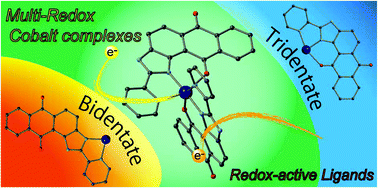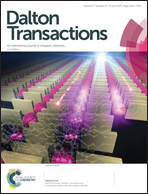Cobalt complexes with redox-active anthraquinone-type ligands†
Abstract
Three anthraquinone-type multidentate ligands, HL1–3 (HL = 2-R-1H-anthra[1,2-d]imidazole-6,11-dione; HL1: R = (2-pyridyl), HL2; R = (4,6-dimethyl-2-pyridyl), HL3; R = (6-methoxy-2-pyridyl)), were prepared, and their complexation behaviour was investigated. Three bis-chelate cobalt complexes with the formula [CoII(L1–3)2]·n(solv.) (1, 2, and 3 for HL1, HL2, and HL3, respectively), in which the ligands adopted tridentate binding modes, were synthesized and structurally characterized by single-crystal X-ray analyses. Electrochemical studies of 1–3 in CH2Cl2 reveal three reversible redox waves, assigned to ligand and cobalt-centred processes. Additional complexes were obtained in which HL1 adopted a bidentate binding mode, stabilising the mono-chelate [CoII(HL1)(NO3)2(DMF)2] (4) species and tris-chelate [CoIII(L1)3] (5) complex in which the cobalt ion was in its 3+ state. The electrochemical properties of complex 5 were investigated in DMF, and the Co(II)/Co(III) redox couple was found to be negatively shifted compared to that of complex 1, while the ligand-based processes became irreversible. Tridentate chelation is found to stabilise the anthraquinone ligands and unlocks their redox multi-stability.



 Please wait while we load your content...
Please wait while we load your content...